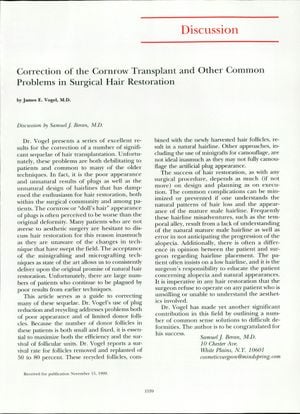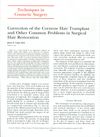Correction of the Cornrow Transplant and Other Common Problems in Surgical Hair Restoration
April 2000
in “
Plastic and Reconstructive Surgery
”

TLDR Dr. Vogel improved hair restoration by reducing and recycling hair plugs, achieving a more natural look and a 50-80% survival rate for replanted follicles. He emphasized understanding natural hair loss patterns, educating patients about alopecia, and refusing to operate on those who don't understand these aesthetics.
In the document from 23 years ago, Dr. James E. Vogel discussed the correction of significant issues in surgical hair restoration, such as the unnatural appearance of hair plugs and hairlines, which were common with older techniques. These issues often resulted in worse outcomes than the original hair loss problem and deterred many from considering hair restoration. Dr. Vogel's approach involved the use of plug reduction and recycling, which addressed both the aesthetic issues and the problem of limited donor follicles. He reported a survival rate of 50 to 80 percent for follicles that were removed and replanted. This, combined with newly harvested hair follicles, resulted in a more natural hairline. The document emphasized the importance of understanding natural hair loss patterns and the appearance of the mature male hairline in successful hair restoration. It also stressed the need for patient education about alopecia and natural appearances, and the surgeon's responsibility to refuse to operate on any patient who does not understand these aesthetics.




